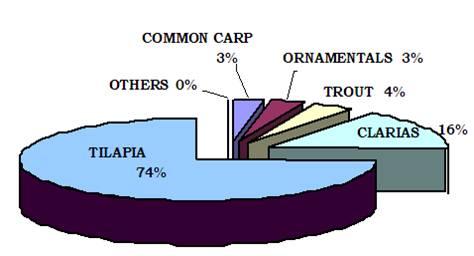Credits: Biovision-Infonet
Aquaculture refers to the farming (propagation and rearing) of aquatic (water dwelling) organisms that include fin fish, mollusks, crustaceans and aquatic plants in controlled or semi controlled environments. The farming activities involve interventions such as stocking, feeding and protection from diseases and predators to enhance productivity.
However Aquaculture is used interchangeably with other terms like fish farming, pisiculture, pond fisheries and pond culture.
Mariculture refers to aquaculture done in marine (ocean) environments.
Some examples of aquaculture include:
- Algaculture: Production of seaweeds and other algae
- Fish farming: Farming of Fin fishes (e.g. Tilapia), shrimps, shellfish, cultured pearls etc.
Aquaculture production is what is produced from aquaculture activities meant for harvest and human use. Although aquaculture is a fairly new concept in Kenya, it has a long history in Asia and Europe. It is believed to have started in China as early as 500 BC.
There are many different species cultured. The different species have different biology and therefore different ecological requirements. They will therefore have different feeding, breeding and water quality requirements. Coupled with different management and intensification levels used, aquaculture production is very varied and diverse.
Aquaculture in Kenya
In Kenya, resources have been spent to promote aquaculture development through various aquaculture projects over the last few decades. The promotion started in the early 1920s as a means of supplementing protein sources in the rural areas. This was a non-commercial approach and it was promoted only as a family subsistence activity. This has however changed over the years and many investors have now invested in commercial aquaculture. Majority of aquaculture activities in Kenya involves the production of various species of tilapia (mainly Oreochromis niloticus) and the African catfish (Clarias gariepinus) and Rainbow trout. The tilapia and catfish production is mainly done as mono or polyculture of the two under semi-intensive systems using earthen ponds while the Rainbow trout production is done in intensive raceways and tank systems. The Tilapine species constitute about 90% of aquaculture production in Kenya. Although most of the production targets the food fish market, there has been an increasing demand for baitfish for the Nile Perch capture of Lake Victoria. Several entrepreneurs are producing the catfish juveniles for this market. Ornamental fish production is also gaining interest and several producers are engaged in the production of gold fish and koi carp among other ornamental species.

(c) Mbugua Mwangi

(c) Mbugua Mwangi

(c) Mbugua Mwangi

(c) Mbugua Mwangi
There are two broad aquaculture divisions in Kenya:
- Marine aquaculture
- Fresh water culture
With
an Indian Ocean coastline of about 600 km, mariculture is yet to
realise any sensible development and therefore fresh water culture
dominates aquaculture activities.
Fresh water aquaculture can be divided into:
- Cold water culture involving culture of Rainbow trout (Oncorhynchus mykiss) in highland areas
- Warm water culture involving the culture of Tilapine fishes, the African catfish, common carp and a variety of ornamental fishes in low land regions of the country
The total area under
aquaculture in Kenya stands at 722.4 ha which include culture-based
fisheries. National average productivity stands at about 5.84 Mt/ha/year
while the total production from this utilized area average 420,000 kg
per year.
The Fish Farming Enterprise Productivity Program (FFEPP), started in mid 2009 and aimed at increasing production of farmed fish from 4000 MT to over 20,000 MT in the medium term and over 100,000 MT in the long term. In the first year of the program, over 27000 fish ponds were dug; 200 ponds in each of 140 constituencies countrywide. This alone created a national short-term demand of about 28 million certified tilapia and catfish fingerlings and over 14,000 metric tonnes of formulated fish feeds. The multiplier effect resulting from farmers digging their own ponds is expected to increase the demand for fingerlings to over 100 million and the demand for fish feeds to 100,000 MT in the medium term (Charo-Karisa and Gichuri, 2010).